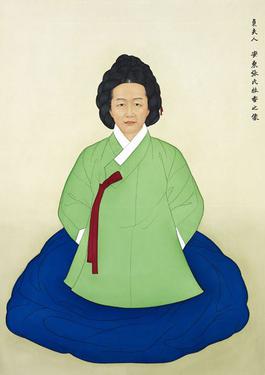Jang Gye-hyang facts for kids
Quick facts for kids
Jang Gye-hyang
|
|
|---|---|

portrait
|
|
| Born |
Korean: 張 桂香
24 November 1598 Andong, Gyeongsang Province, Korea
|
| Died | 7 July 1680 (aged 81) Seokbochon, Yeongyang County, Gyeongsang Province, Korea
|
| Nationality | Korean |
| Other names | Chang Kye-hyang, Chŏngbuin Andong Chang Ssi, Chŏngbuin Chang Ssi, Korean: 정부인 안동 장씨 |
| Known for | one of the first cookbooks written by a woman in Korea, first cookbook using the Korean alphabet |
|
Notable work
|
Eumsik Dimibang (Korean: 음식디미방) |
Jang Gye-hyang (Korean: 장계향; Hanja: 張桂香, born November 24, 1598 – died July 7, 1680) was an amazing Korean noblewoman from the Joseon era. She was known for many talents! In her younger years, she studied the Korean alphabet called Hangul and wrote beautiful poems. She was also a talented painter and a very kind person who helped others (a philanthropist).
One of her biggest achievements was writing one of the first cookbooks in Korea. What makes her cookbook so special is that it was written by a woman, and it was also written using the Korean alphabet, Hangul. This was a big deal because, at that time, the official writing system was Chinese. Her book was also unique because it showed how to actually prepare food, not just talk about its health benefits.
Early Life and Learning
Jang Gye-hyang was born on November 24, 1598, in Andong, which is in Gyeongsang Province, Korea. She was the only daughter of Jang Heung-Hyo and Andong Kwon. Her father was a famous scholar who followed Neo-Confucian ideas. He taught many students right in their home.
While her father's students were busy studying, young Jang Gye-hyang would secretly explore his library. She loved to read books about writing and philosophy. During the Joseon era, it was not common for women to get an education. If they did, it was usually for women from the upper classes and focused on philosophy and good manners, not practical skills.
But Jang Gye-hyang was different! By the time she was ten years old, she was already very good at writing. When she was thirteen, she was writing her own poems. Some of her early poems, like "Ode to the Saint" and "Sound of Rain," showed how wise she was, even at a young age. Her father was very impressed by her talent. During this time, she also created paintings and embroideries, though not many of them still exist today. When she was 19, Jang married Yi Si-myeong. She was his second wife, and her father had introduced them.
Later Life and Helping Others
After Jang Gye-hyang got married, she and her husband first lived in a seaport town called Yeonghae. Later, they built a home in a mountain village called Seokgye, which is in North Gyeongsang Province. This village is famous for being the hometown of the novelist Yi Mun-yol. Jang Gye-hyang raised her own seven children, and she also cared for the two children from her husband's first marriage.
During a difficult time in Korea, the Second Manchu invasion of Korea in 1636, many people suffered. Jang Gye-hyang opened her home to help those who were struggling and had little food. She also planted an orchard of acorn trees. She did this so that poor people would always have a source of food, showing her great kindness.
Her Famous Cookbook
It is believed that Jang Gye-hyang wrote her famous cookbook, Eumsik Dimibang (Korean: 음식디미방), in her later years, around the 1670s. We know this because she wrote a note in the book about her age and her eyesight getting weaker.
Before her book, some instructional books about food had appeared in Korea. However, most of them were like encyclopedias, focusing on the medicinal uses of food. They were also written in classical Chinese. Jang Gye-hyang's cookbook was special because it was written in the Korean alphabet. It is often called the first cookbook written in Hangul.
Her book contains recipes and clear instructions for making 146 different dishes! These include drinks, dumplings, meats, noodles, seafood, soups, and vegetables. Jang Gye-hyang was very detailed in her instructions, showing that she truly understood how to cook. This made her cookbook very different from others written before it.
Her Legacy
Jang Gye-hyang passed away on July 7, 1680, in Seokbochon village in Yeongyang County, Gyeongsang Province. Her cookbook was not printed during her lifetime. However, it was discovered in 1960 in the home of Yi Karam (Korean: 李葛菴) and later published.
Jang Gye-hyang's writings show that some women in the Joseon era were able to challenge traditional ideas. Her cookbook is a very important tool that helped turn cooking from just something families taught each other into a field of study. Today, some of the dishes she created are served at the Korea House Restaurant in central Seoul. The Ministry of Tourism even offers tours to places mentioned in her book, and it has its own page on the Google Cultural Institute!

